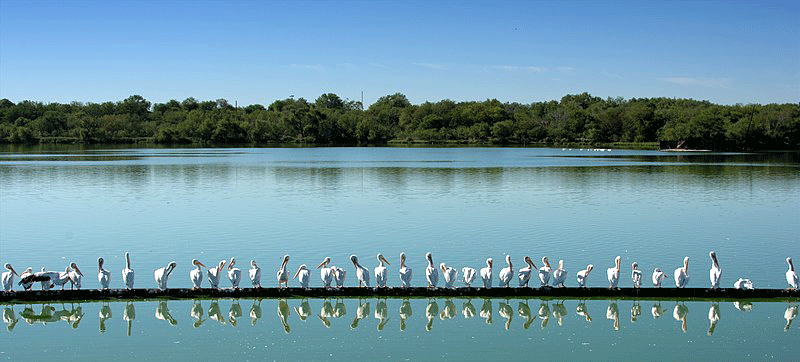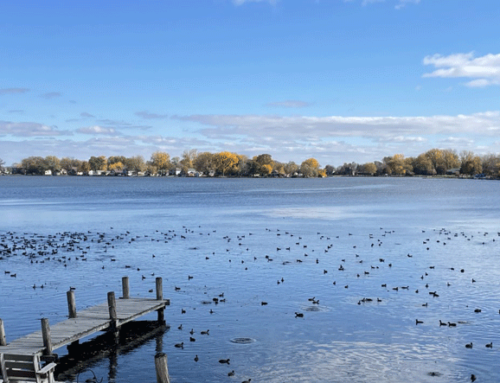The American White Pelican (Pelecanus erythrorhynchos) used to be a rare sight in Wisconsin, now these birds, with wingspans up to 9 feet, are frequently spotted in large numbers in the Winnebago System! The American White Pelican has an orange, long, pouched bill (beak) that can grow a protrusions during the breeding season. The tips of their bills have a small hook at the tip. Their necks are long, and their bodies are usually snowy white with black flight feathers. Their legs and feet are orange though younger birds’ can appear more gray-pink and darken with age, and their feet are webbed. Adult pelicans can weigh about 16 pounds, making them one of the heaviest flying bird species.
American White Pelicans are piscivorous, meaning they primarily eat fish. The American White Pelican forages for food mostly in shallow waters in open areas of marshes, lakes, rivers, and ponds but can forage in deeper water. American White Pelicans do not submerge or dive for food. Instead, they dip their bill into the water and scoop up prey into their pouch, then tip their bill above their head to swallow. A typical pelican can reach down to about 3 feet below the surface of the water, and can eat about 3 pounds of fish a day! In Wisconsin, pelicans have been recorded eating common carp, as well as other fish species. They can also eat amphibians like frogs and invertebrates like crayfish. Pelicans sometimes work together to forage for food. A group of pelicans can corral fish into shallow areas or to the center of a U formation or circle to more easily catch prey.
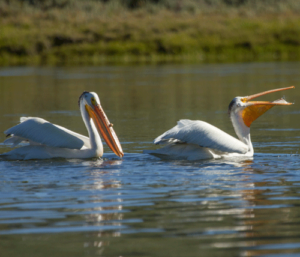
Adult American White Pelicans on Water (National Park Service)
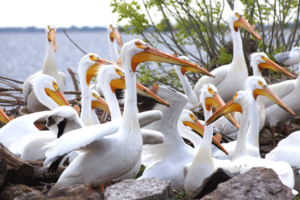
Pelicans at a nesting colony (Winnebago Waterways User Submitted Photo)
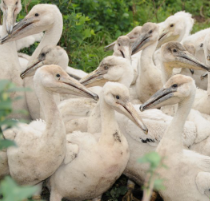
Young Pelicans (USDA)
Pelicans start to breed when they reach about 3-6 years old and travel to their breeding colonies in March – May. These colonies are typically on islands. Nests are built on the ground in colonies with other pelicans, as well as other bird species like cormorants and gulls. Usually pelicans lay 2 eggs. The eggs and hatched young are vulnerable to predators like eagles, foxes, and raccoons. Studies show that pelicans can live up to 30 years.
Historically, American White Pelicans were found in Wisconsin but their population sharply declined in the late 1800s – 1900s due to hunting and habitat loss. In the last 20-25 years, their populations have grown tremendously in Wisconsin, prompted likely by loss of breeding grounds in the West but also due to habitat restoration projects and pollution cleanup. In the lower Green Bay area, the number of white pelicans grew from about 250 in 2005 to more than 3,000 in 2021. Protecting their habitat and water quality is important to their continued success in the Winnebago System.
Article written by Katie Reed, Winnebago Waterways Coordinator: katherine@fwwa.org
Featured Image Credit: Russ CC BY 2.0
Sources:
The Cornell Lab: All About Birds – American White Pelican
American White Pelican – EEK Wisconsin – Environmental Education for Kids
USDA – Tommy King – Animal & Plant Health Inspection Service – American White Pelicans
SeaGrant – University of Wisconsin – Researchers investigate the impact of water birds on Green Bay
Winnebago Waterways is a Fox-Wolf Watershed Alliance recovery initiative. Contact us at wwinfo@fwwa.org


